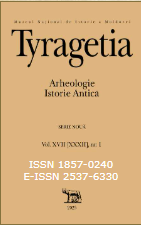Timpurile se Schimbă. Noi Date Despre Situl Epocii Fierului De La Horodiște Din Bazinul Nistrului De Mijloc
Times are changed. New data on the Iron Age site from Horodiște, Middle Dniester Basin
Author(s): Aurel Zanoci, Daniel Scherf, Mihai BăţSubject(s): Archaeology, Cultural history, Social history, Prehistory
Published by: Muzeul Naţional de Istorie a Moldovei
Keywords: Iron Age; Middle Dniester Basin; Saharna culture; Getae culture; hillfort; settlement;
Summary/Abstract: Located on the northeastern outskirts of the village of Horodiște (Rezina district), an archaeological site with the same name was discovered in the second half of the 1940s and attributed to the hillforts of the late Iron Age. Surveys carried out in 2013 provided the first information on the chronology of this site, revealing two Iron Age cultural layers: the Saharna culture and the Getae culture. In 2019, the surface of the site was investigated using geophysical methods, which made it possible to identify numerous anomalies associated with human activity and the presence of underground archaeological structures. One of the anomalies on the La Cot plateau, believed to be the remains of a ditch, was intrusively explored in 2021. Excavations confirmed the presence of a ditch, trapezoidal in section, with a mouth width of about 3.50 m, a width at the bottom of 1.40 m and a depth of 0.90 m. Behind it, the remains of a “wall” 1.20-1.50 m wide were found, consisting of two wooden frames, between which a filling of earth and stone was compacted. The fragments of pottery recovered from the ditch and from the filling of the “wall” are characteristic of the Saharna culture, dating back to the Early Iron Age. During archaeological excavations in 2022, a “rampart” and a defensive ditch on the south-eastern side of the La Șanț promontory were explored. As a result of the work, it was established that the “rampart” was the remains of a wall about 4 m wide, the outer frame of which was stone and the inner frame was wooden, the space between them was filled with clay soil, gravel and crushed stone. At a distance of about 4.0 m from the wall, a V-shaped ditch was explored, with a mouth width of about 5.30 m and a depth of about 2.40 m. Artifacts discovered during excavations of the “rampart” and ditch allow us to date this defensive line to the 4th-3rd centuries BC. Thus, archaeological investigations in 2021-2022 confirmed the presence of two phases of habitation at the Horodiște site: the Early Iron Age – the Saharna culture, and the Late Iron Age – the Getic culture.
Journal: Tyragetia (Serie Nouă)
- Issue Year: XVII/2023
- Issue No: 1
- Page Range: 195-227
- Page Count: 33
- Language: Romanian

